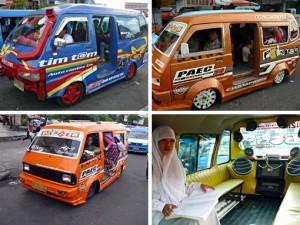 Last week I wrote a post asking if the kotatsu could ever make it in the US. This week we look at Lyft, a company inspired by the Angkot transportation system in Indonesia. In most developing and urbanizing countries residents have to get around chaotic cities without the luxury and comfort of the private car, or the independence of the motorbike. In Indonesia, passenger ferries and cheap flights do long haul duties at reasonable rates, larger buses do intra-city trips, and in most cities, Angkot do the rest.
Last week I wrote a post asking if the kotatsu could ever make it in the US. This week we look at Lyft, a company inspired by the Angkot transportation system in Indonesia. In most developing and urbanizing countries residents have to get around chaotic cities without the luxury and comfort of the private car, or the independence of the motorbike. In Indonesia, passenger ferries and cheap flights do long haul duties at reasonable rates, larger buses do intra-city trips, and in most cities, Angkot do the rest.
In Indonesia, the Angkot is built by several companies, with Suzuki and Mitsubishi making the lion’s share. As the picture above shows the angkot has small wheels, a tiny engine, and usually has very simple bench seats although, rows of tiny seats are the norm in Manado, and some other cities. Low cost and durability are definitely the priority and safety features are pretty much nonexistent. But it isn’t the hardware that makes the angkot interesting. It’s how its used.
Like buses angkot move in prescribed routes around the city, usually linking other transportation hubs like intercity bus and train stations, or to megamalls and colleges. However, unlike buses which can’t easily divert from set routes, the small size of the angkot means that a passenger can request the driver to make slight alterations that buses won’t. In an angkot, for example, passengers can easily request minor detours or charter the car for the day, or have the car drop the passenger off directly in front of where they want to go, or haul loads that buses won’t allow. Also unlike buses, the sheer number of angkot on the streets means that you don’t need to wait at bus stop; you just flag them down on the street. In such a way the angkot system bridges the gap between private and public cars. It sort of like a taxi,except there are often several people going to different places albeit along the same general route.
In San Francisco, where the cost of owning a car is too expensive; taxis are tough to find; and buses often cater to the strung-out and the crazy, a new startup called Lyft is trying to adopt what works with the angkot model. Whereas in Indonesia the drivers are professionals, Lyft drivers are pretty much regular folks who use their private vehicles and paint a pink mustache on the front to designate that they’re Lyft cars. The Lyft smartphone app lets potential fares know where Lyft drivers are and allows them to book a ride. After the fair is completed (called a donation to avoid angering taxi drives) both the driver and the passenger rate one another for the quality of the ride, in the same way that ebay sellers and buyers build trust through the rating system.
There seems to be a lot with the model that still needs to be worked out, especially questions over insurance, liability, and the blowback from the taxi industry, but the general idea makes a lot of sense, especially from an environmental point of view. More ridesharing through a service like Lyft means fewer vehicles on the road, and therefore less traffic and less pollution and maybe a better sense of community.
[Photo by author all rights reserved]

